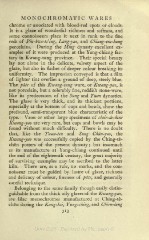Page 387 - Oriental Series Japan and China, Brinkly
P. 387
MONOCHROMATIC WARES
chrome or associated with blood-red spots or clouds.
It is a glaze of wonderful richness and softness, and
some connoisseurs place it next in rank to the fine
reds of Pin-kwo-ts'ing, Lang-yao, and Chiang-tou-hung
porcelains. During the Ming dynasty excellent ex-
amples of it were produced at the Yang-chiang fac-
tory in Kwang-tung province. Their special beauty
lay not alone in the delicate, velvety aspect of the
glaze, but also in flashes of deeper colour breaking its
uniformity. The impression conveyed is that a film
of lighter tint overlies a ground of deep, steely blue.
The pate of this Kwang-tung ware, or Kwang-yao, is
not porcelain, but a tolerably fine, reddish stone-ware,
like its predecessors of the Sung and Tuan dynasties.
The glaze is very thick, and its thickest portions,
especially at the bottom of cups and bowls, show the
profound, semi-transparent blue characteristic of the
type. Vases or other large specimens of clair-de-lune
Kwang-yao are very rare, but cups and bowls may be
found without much difficulty. There is no doubt
that, like the Tuan-tsu and Sung Chun-yao, the
Kwang-yao was successfully copied by the Ching-te-
chen potters of the present dynasty ; but inasmuch
as its manufacture at Yang-chiang continued until
the end of the eighteenth century, the great majority
of surviving examples may be ascribed to the latter
kiln. There are, as a rule, no marks, and the con-
noisseur must be guided by lustre of glaze, richness
and delicacy of colour, fineness of pate, and generally
careful technique.
Belonging to the same family though easily distin-
guishable from the thick oily glazes of the Kwang-yao,
are lilac monochromes manufactured at Ching-te-
chen during the Kang-hsi, Tung-ching, and Chien-lung

